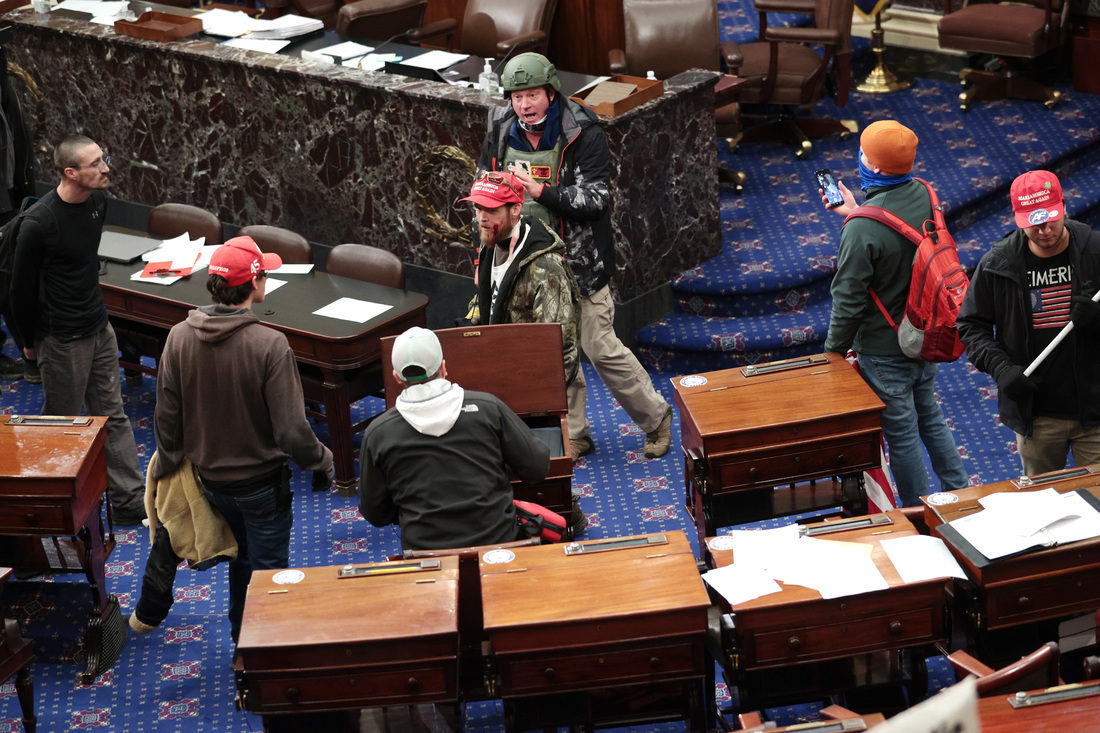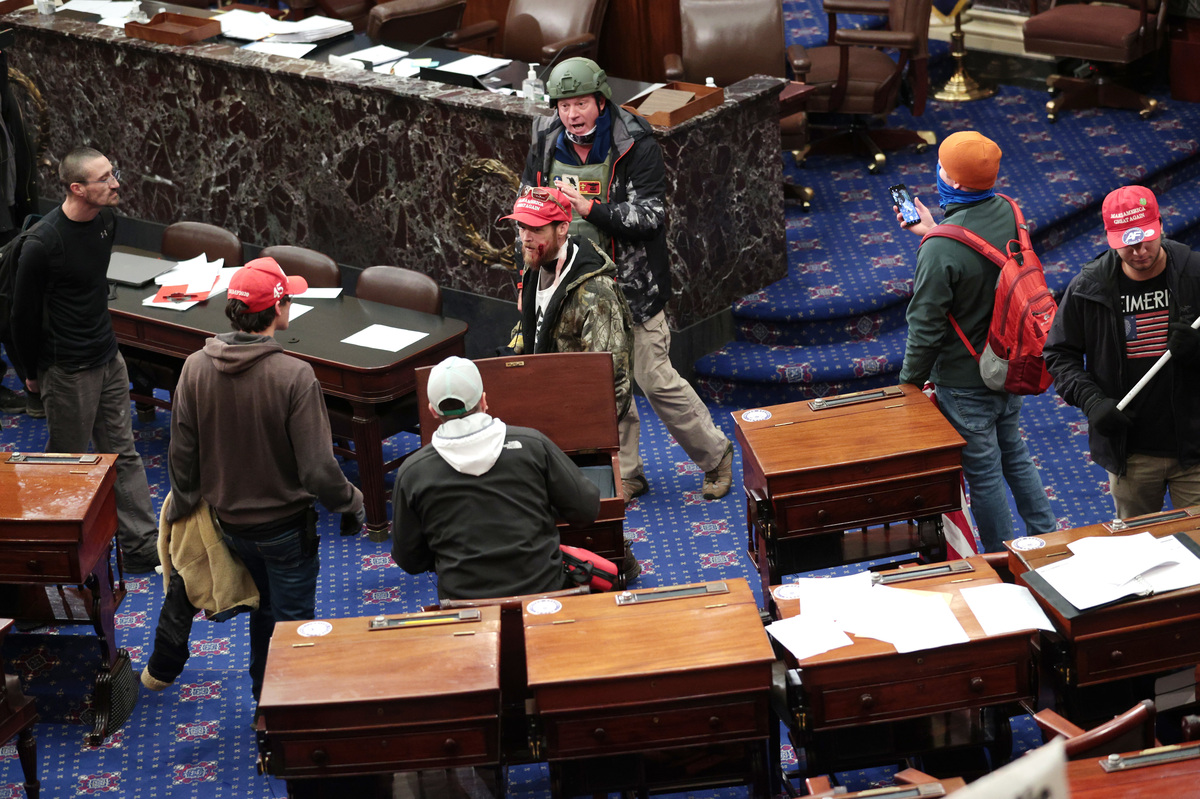[ad_1]

Bruno Cua, 18, is allegedly seen here with his back to the camera, holding a tan jacket. Prosecutors say he entered the Senate Chamber of the U.S. Capitol on Jan. 6 with a handful of other rioters.
Win McNamee/Getty Images
hide caption
toggle caption
Win McNamee/Getty Images

Bruno Cua, 18, is allegedly seen here with his back to the camera, holding a tan jacket. Prosecutors say he entered the Senate Chamber of the U.S. Capitol on Jan. 6 with a handful of other rioters.
Win McNamee/Getty Images
Before Jan. 6, 18-year-old Bruno Cua was best known in his small town of Milton, Ga., as a great builder of treehouses. These were big, elaborate creations with ladders and trapdoors and framed-out windows. They were so impressive, neighbors paid Cua to build them for their kids.
The world outside Milton, Ga., met Cua in a rather more dramatic way. He was allegedly seen in multiple videos standing in the Senate Chamber of the U.S. Capitol with a handful of other rioters. The videos have since gone viral: There’s a man in combat gear, now identified as Air Force veteran Larry Brock, Jr., chiding rioters, including Cua, about why they shouldn’t sit in Vice President Mike Pence’s chair. Cua seemed confused. “They can steal an election, but we can’t sit in their chairs?” he asked.
In a defense motion filed on Friday, Bruno Cua’s lawyers said their client “is an impressionable 18-year-old kid who was in the middle of finishing his online coursework to graduate from high school when he was arrested.”
They paint a portrait of a young man swept up by events. “In many ways, he is less of an ‘adult’ than many teenagers,” the motion said. “He has never lived away from his parents. He has lived his entire life in the area immediately surrounding Atlanta.”
Prosecutors, for their part, see Cua through a very different lens. In a criminal complaint, they point to Cua’s social media posts in the run-up and aftermath to Jan. 6 to suggest that he was someone who was genuinely inspired by former President Donald Trump and intent on violence.
Cua’s case is a stark example of just how powerful misinformation can be. Both prosecution and defense agree that he was radicalized by what he read online, and the decision to embrace the falsehoods he discovered in chatrooms and social media changed the course of his life. And he wasn’t alone. More than 250 people have been charged so far with breaching the Capitol and most of them, to varying degrees, were motivated to storm the building by the falsehoods they had been reading online and in social media for months.

Bruno Cua’s lawyers said he was “an impressionable 18-year-old kid” swept up by the events of Jan. 6. But prosecutors say his social media posts ahead of the Capitol riot show a young man intent on violence.
The Cua family
hide caption
toggle caption
The Cua family

Bruno Cua’s lawyers said he was “an impressionable 18-year-old kid” swept up by the events of Jan. 6. But prosecutors say his social media posts ahead of the Capitol riot show a young man intent on violence.
The Cua family
“President Trump is calling us to FIGHT!” Cua allegedly wrote on Parler days before the siege. “It’s time to take our freedom back the old fashioned way.”
Cua’s lawyers say the messages prosecutors see as threatening were the “idle chatter of an extremely passionate, but very naive, teenager who was parroting what he heard and saw on social media.” They made clear that these ideas weren’t things that Cua came up with on his own, instead they were fed to him online. He was radicalized, they said, by social media.
According to the defense motion, Cua had traveled to Washington, D.C. on Jan. 6 with his parents to attend a Trump rally. His parents were long-time Trump supporters and Cua had become one too. They had walked to the Capitol together, as a family, when a melee erupted on the Capitol steps. Bruno Cua asked his parents if he could go and take a closer look. They agreed and Cua quickly disappeared into the crowd. His parents only found out later, his lawyers said, that he had entered the Capitol and walked into the Senate chamber.
Surveillance video inside the Capitol allegedly showed him wearing a dark sweatshirt, a jean jacket, a red “Make America Great Again” hat and gray gloves wielding a baton and trying to open various office doors.
In a criminal complaint, federal prosecutors cite a Jan. 6 Instagram post in which Cua allegedly wrote, “Yes, we physically fought our way in.” Another post read: “Yes, for everyone asking I stormed the [Capitol] with hundreds of thousands of patriots. I’ll do a whole video explaining what happened, this is history. What happened was unbelievable.”
The FBI allegedly received two tips identifying Cua as the young man who stood in the Senate chamber on Jan. 6. His clothing helped authorities identify his movements and actions throughout the Capitol that day, they said.
Another tipster, according to court documents, told authorities that Cua had been talking about going to Washington on his Parler account for days and “actively encouraged the events on the sixth for 11 days leading up to the domestic terrorist attack,” the complaint said.
Cua, who is believed to be the youngest person so far to be charged with storming the Capitol, allegedly assaulted a federal officer. His lawyers say that as part of his conditions for release he would be willing to stay off social media and be monitored in his parent’s house.
Since the events in January, Cua has completed three online courses: College Algebra, Intro to Government and Intro to Marketing, his lawyers said. He is three classes away from a high school diploma, they added.
[ad_2]
Source link